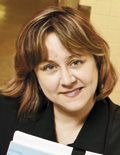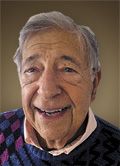How pharmacists are helping patients kick the habit
CVS decided to abandon tobacco sales in 2014. Plenty of community pharmacists were way ahead on that one.
At Goodykoontz Drug Store in the tiny town of Bluefield in West Virginia's coal country, it doesn't take a detective to figure out which patients are smokers. Pharmacy manager Beth Kelli Louthan, PharmD, just uses her nose and her eyes.
"You smell it on people," she said, "or they bring out their cigarettes and their wallets at the same time. Or they might put their cigarettes in their shirt pockets, or they talk about smoking."
See also: MTM essentials for smoking cessation
If these clues aren't apparent, pharmacy records reveal which patients never picked up prescriptions for anti-smoking products.

Beth Kelli Louthan
So Louthan found it easy to find 18 smokers to enroll in a West Virginia pilot smoking-cessation program. She started working with the patients in March this year, hooking them up with services provided by the state quit line and giving them free supplies of lozenges and patches for smoking cessation.
By six weeks in, nine of the initial 18 participants had stopped smoking and another four had enrolled.
"One of them is quitting this week, and her mom is quitting with her," said Louthan, who spoke with Drug Topics in mid-May. "I hope that the two of them are successful."
Other West Virginia pharmacies are taking part in the pilot program, which seeks to gain insight into whether a combination of training and financial incentives can turn pharmacies into powerhouses of smoking cessation. Judging by previous projects, the odds are good that it will work.
See also: Helping smokers kick the habit

Karen Hudmon"Research has cemented the fact that pharmacists can do this," said Karen Hudmon, RPh, DrPH, MS, professor of pharmacy practice at Purdue University. "They can have a meaningful role."
Expansion of these efforts is facing many challenges, however, from pharmacy workers who already feel overworked to drugstores that may feel conflicted about pushing smoking cessation while selling tobacco products. The crucial issue of reimbursement is still being worked out, and provider status remains elusive.
Hudmon is hopeful, nevertheless. "Weâre the leaders on this. That's why itâs so important that we be given the opportunity to furnish the prescriptions without a doctor's orders. Let us have that capacity, so we can help patients."
History lesson: Smoking cessation
Even in the year 2016, patients can still pick up a pack of Marlboros, a vape starter kit, or a box of cigars at many chain drugstores that promote themselves as health centers. In fact, the tobacco industry has enjoyed a "long and very cozy relationship" with leading drugstore chains, reported a journalism professor and a health policy expert in a JAMA Oncology commentary last December. [JAMA Oncol. 2015;1(9):1215-1216]
Things may be changing, thanks to the widely praised 2014 decision by CVS to abandon tobacco sales. But what about community pharmacies? Turns out they've long been ahead of their chain counterparts.

Fred MayerIn 2010, the American Pharmacists Association (APhA) urged pharmacies to stop selling tobacco products. A half-century before that, in 1960, Northern California pharmacist Fred Mayer, RPh, MPH, created what may be the first pharmacy-based smoking cessation program in the nation.
Mayer, who's now 84 years old and still a leader in the pharmacy world (and a longtime member of Drug Topics' editorial advisory board), required smokers to bring in a doctor's prescription to take part in his quit-smoking program. Heâd collect $50 in cash from each smoker; if the smoker quit, Mayer would collect reimbursement from the insurer and give the money back to the patient.
"We got training, we hung out our shingle, and we got reimbursed," he said. The result: He helped hundreds of people to quit smoking. In the process, he founded the Great American Smokeout, which has helped countless others to put down their cigarettes as well.
Pharmacy workload
Fast-forward to the 21st century. While the number of pharmacists who help patients quit smoking seems to be small, it's on the rise.
At the APhA annual conference in 2015, Hudmon asked an audience of pharmacists how many had helped their patients quit smoking. Several hands went up.
"Eight years ago," she told the crowd, "no one raised their hand."
Boosting these numbers further is a challenge, and some of the best minds in pharmacy are seeking solutions.
One big obstacle is the workload.

Lisa Kroon"We recognize that pharmacists are very busy and have limited time to provide a direct patient-care service," said Lisa Kroon, PharmD, CDE, professor and T.A. Oliver Chair in Clinical Pharmacy at the University of California, San Francisco School of Pharmacy.
So in an experiment, Kroon and colleagues focused on training Safeway pharmacy staff to adopt brief interventions based on an ask-advise-refer model, which has been successfully tested among dentists and dental hygienists.
Ask about tobacco use
Here's how the program works. "You ask the customer about tobacco use and assess the readiness to quit," Kroon said. "If a person is ready to quit, the pharmacist can be brought in to assess medications for them." Patients can also immediately be linked to the state quit line, Kroon said.
According to findings of a study made by Kroon and her colleagues, only 16% of 44 Safeway pharmacists and 4% of 53 technicians at baseline said they'd asked patients about smoking status in the past week. Those numbers rose significantly over a 12-week training period, reaching 85% participation by pharmacists and 91% by technicians among those who received both written and live training.
The key is to add the tobacco questions to the pharmacy workflow of pharmacists, technicians, and clerks, Kroon said. They ask questions about tobacco use as they routinely compile information about such things as allergies and insurance.
"Most smokers are not ready to quit," she said, "but having that initial conversation can move them forward to think about it."
Even simply adding information about smoking to a patient's record can be helpful, as it may trigger a pharmacist to step in.

Emma Sew Hoy"I was able to proactively bring up smoking cessation with a patient who I knew also had uncontrolled asthma, because I saw tobacco status was documented in the system," said Emma Sew Hoy, PharmD, a community pharmacy resident with Safeway in Northern California. "She was ready to quit, and after discussing information such as current tobacco use and past quit attempts, we concluded that she would use the nicotine patch and lozenge. I counseled her on how to use them effectively and referred her to the California Smokers Helpline. And the patient did not have any out-of-pocket costs, because I was able to furnish these medications."
The ask-advise-refer training program is such a success that it has been expanded nationwide at Safeway and Albertsons stores, Kroon said.
Studies: Pharmacist interventions work
Other approaches have been tested across the country.
In New Mexico, researchers tracked pharmacist cessation efforts based on UCSF's free Rx for Change training program. Over six years, the efforts produced quit rates of 10% to 26%, similar to those in programs offered by other medical professionals. (These results were reported in J Manag Care Spec Pharm. 2014 Jun;20(6):579-587.)
A prospective, controlled study conducted in 2009 by a Rocky Mountain VA system randomly assigned smokers to two cessation programs. In one, participants took part in three face-to-face group sessions with pharmacist teams; in the other, they received standard care sessions via phone conversations. They also received free immediate-release bupropion or nicotine patch.
At the end of six months, tests confirmed that 28% of those who took part in the face-to-face treatment group had quit, compared to 12% in the standard care group. (Study findings were published in Ann Pharmacother. 2009 Feb;43(2):194-201.)
At the VA system in San Diego, 16% of smokers who took part in a telephone-based cessation clinic run by pharmacists had quit smoking at six months, compared to 10% of another group. Both groups received medication.
Whatâs next?
In West Virginia, the pilot program continues through June, funded at six pharmacies through a $10,000 grant. Pharmacists call participants weekly for six weeks, and they're reimbursed both for an initial 20-minute session and for follow-up calls, said Jamie Mask, Pharm.D., a community pharmacist consultant. Pharmacists will receive a bonus if the quit rate among their participants is higher than the national average, she said.
"The goal here was to help patients quit smoking. We've definitely not excluded anybody," Mask said. "Whether they're on Chantix or they wanted to quit cold turkey, they were included. It's mainly about the accountability of that pharmacist, checking in with the patients on a regular basis."
In some states, pharmacists can do more than ask, advise, and refer. In California, they are now authorized to furnish nicotine replacement drugs.
"They can directly submit prescription insurance claims for these medications," said Sew Hoy, the community pharmacy resident. "This allows pharmacists to provide smoking-cessation services more comprehensively, so that patients receive their medications faster and more inexpensively, along with a full consultation with the pharmacist."
There have been glitches along the way. Mayer, the smoking-cessation pioneer, said that getting insurers to pay up in California has been a challenge.
Whatt's next? Overall, it seems likely that more time will be needed and details worked out before community pharmacists embrace this new role.
But Louthan, the West Virginia pharmacy manager, is proud to on the cutting edge when it comes to helping people cut out cigarettes. As she put it, "It's where we need to be."
Randy Dotinga is a medical writer based in San Diego.